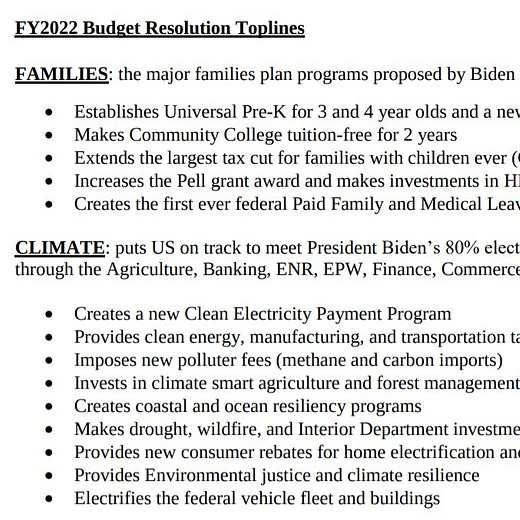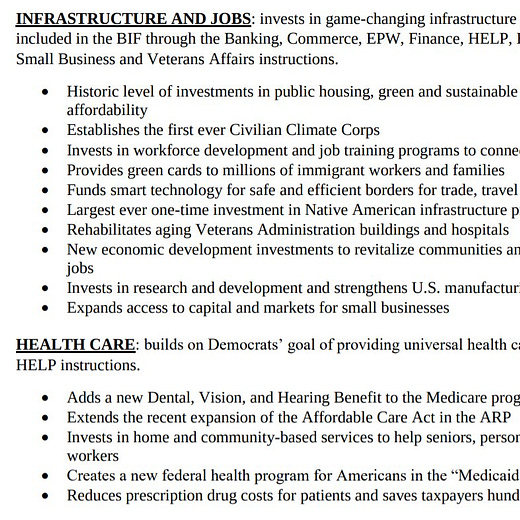August 9, 2021
It appears the Senate is on track to pass the bipartisan $1 trillion “hard” infrastructure package as early as tomorrow morning.
As soon as it passes, Democrats will turn to the $3.5 trillion bill, a sweeping measure that would modernize the nation’s approach to infrastructure by including human infrastructure as well as the older “hard” projects. It establishes universal pre-kindergarten for 3- and 4-year-olds, cuts taxes for families with children, makes community college tuition free for two years, and invests in public universities.
It invests in housing, invests in job training, strengthens supply chains, provides green cards to immigrant workers, and protects the borders with new technologies. It expands the Affordable Care Act, invests in home and community-based health care, and reduces the cost of prescription drugs.
It also invests significantly in measures to combat climate change. Focusing on clean electricity, it cuts emissions through tax incentives, polluter fees, and home electrification projects, and replaces federal vehicles with electric ones.
The bill calls for funding these measures with higher taxes on corporations.
The measure will move forward as a budget resolution that simply says how much money the government expects to need next year, and from 2023 to 2031. Once it passes, the various committees will hammer out exactly how much money should go where, and Congress will then hammer that into some form of an agreement.
Once a measure is finalized, the Senate will try to pass the bill through the process of budget reconciliation, which cannot be filibustered, meaning that it can pass with a simple majority.
If, indeed, President Joe Biden manages to pass both a bipartisan bill that pleases some Republicans and the reconciliation bill that pleases progressive Democrats, it will be an astonishing accomplishment.
One thing that is not in the larger bill is an increase to the debt limit, which will be imperative before October. Raising the debt limit is necessary because Congress has already appropriated money that the Treasury does not have, so it will have to borrow to meet existing obligations.
Senate Minority Leader Mitch McConnell has threatened that neither he nor any other Republican will lift the debt limit and that Democrats must do it alone. But Democrats are not willing to raise it themselves, when it was the Republicans who ran up the debt during Trump’s term, adding $7 trillion to the debt while they slashed corporate taxes. ″The vast majority of the debt subject to the debt limit was accrued before the administration taking office,” Treasury Secretary Janet Yellen told Congress on Monday. “This is a shared responsibility, and I urge Congress to come together on a bipartisan basis as it has in the past to protect the full faith and credit of the United States.”
The large infrastructure package will reshape American society to invest in ordinary Americans and to get the nation on track to face a future that does not center around fossil fuels. That such an investment is on the table right now seems like good timing, since today, the Intergovernmental Panel on Climate Change (IPCC) of the United Nations released the most thorough report on climate ever compiled, and the conclusions are a “code red for humanity,” according to United Nations secretary-general Antonio Guterres. The report is based on more than 14,000 studies and is endorsed by 195 governments.
It warns that we have waited too long to reduce our use of fossil fuels, guaranteeing that the globe will continue to warm for at least the next 30 years even if we address climate change immediately. This will mean more extreme weather: fires—like the Dixie fire currently raging in Northern California, which is the largest in the state’s history—floods, disease, extinctions, and social conflict. If we address the issue, though, there is still a window in which we could mitigate changes that are even more dire.
The Republicans object to the larger infrastructure bill because it uses the government to invest in the economy, which will cost tax dollars. For forty years, Republicans have called for turning the economy over to private interests and for tax cuts to free up capital for investment, which they argued would make the economy grow. But those policies have sparked discontent as they concentrated wealth upward and ran up huge deficits and debt.
Now, as Democrats want to go back to the sort of system that created our booming post–World War II economy by stopping the concentration of wealth upward and investing in infrastructure, Republicans are complaining that the cost will hobble the nation. They are threatening to refuse to raise the debt ceiling, although as Treasury Secretary Janet Yellen pointed out, Congress assumed the vast majority of the debt that requires a higher limit before President Joe Biden took office.
Meanwhile, Republican policies are not looking very good right now, as Republican governors have stood staunchly against combatting Covid-19 with either masks or vaccines. The virus is now surging again in the U.S., which currently has 17% of the world’s new infections despite having the best vaccine supply. The spike is especially obvious among children, who make up 20% of the nation's new cases, apparently becoming infected in homes where adults are not vaccinated. On ABC, Dr. Mark Kline, Physician In Chief at Children’s Hospital New Orleans, said: “We are hospitalizing record numbers of children. Half of the children in our hospital today are under two years of age, and most of the others are between 5 and 10 years of age.”
Cases continue to rise in Florida and Texas, where governors Ron DeSantis and Greg Abbott have prohibited mask mandates. In Florida, journalist Katherine G. Hobbs reports: “Volusia County and Advent Health Orlando are finalizing the purchase of fleets of refrigerated mobile morgues amid Florida's COVID surge.” In Texas, Abbott today called on Texas hospitals to postpone elective procedures in order to clear more beds for Covid patients. The state’s health department is trying to find more health care workers to come to the state to help out.
Nonetheless, DeSantis and Abbott refuse to modify their ban on mask mandates, clearly seeing a strong stand on this issue as a political statement that they believe will win them Republican voters. But as infections and deaths, especially among children, rise, the wisdom of this move is not clear.
Private companies, courts, and schools are all challenging the governors’ edict. A federal judge has overruled Florida’s prohibition on private companies from asking about vaccine status, a rule challenged by cruise ship lines, who would have faced millions of dollars in fines, although vaccine requirements are standard in other ports they visit. DeSantis says he will appeal.
In Arkansas, where only 37% of the state’s population is vaccinated, two challenges to the state’s ban on mask mandates led a judge on Friday to block the ban temporarily. One of the challenges was brought by a school where more than 900 students and staff are quarantining because of a coronavirus outbreak. In Texas, Austin, Houston, and Dallas Independent School Districts are instituting mask mandates in defiance of Abbott’s executive order.
In Florida, the Miami-Dade school system is the fourth largest school district in the nation. When Superintendent Alberto Carvalho made it clear that he will follow the guidance of public health experts and doctors, DeSantis threatened to withhold the salaries of any superintendents or school board members who defy his executive order prohibiting mask mandates.
Carvalho issued a statement saying “At no point shall I allow my decision to be influenced by a threat to my paycheck; a small price to pay considering the gravity of this issue and the potential impact to the health and well-being of our students and dedicated employees.”
—-
Notes:
https://thehill.com/homenews/state-watch/566943-dixie-fire-becomes-largest-in-california-history
https://www.nytimes.com/2021/08/09/climate/climate-change-report-ipcc-un.html
https://www.cbsnews.com/video/children-make-up-20-percent-of-all-new-covid-cases-across-the-us/
https://www.washingtonpost.com/travel/2021/08/09/desantis-passport-ban-norwegian-cruise/
https://www.politico.com/news/2021/08/09/abbott-texas-hospitals-covid-503066
https://www.cnn.com/2021/08/09/politics/read-senate-resolution-fiscal-year-2022/index.html
https://www.cnn.com/2021/08/09/politics/democrats-budget-resolution-debt-ceiling/index.html
https://www.washingtonpost.com/us-policy/2021/08/09/treasury-yellen-debt-ceiling/
https://www.nytimes.com/2021/08/09/us/politics/infrastructure-senate-biden.html




In war "collateral damage" and "friendly fire" are two regrettable but often unavoidable things that happen. Innocent people die but it's war. If there is any doubt that the GOP's war on democracy has resulted death tolls that rival and surpass actual wars against foreign enemies? Donald Trump loves to ask, "Who killed Ashli Babbit?" The answer is he did. He brought her to Washington and inspired her to participate in the assault on the capitol. A woman died but she's become a good line to use at rallies. The vaccine debate might be expected at the Flat Earth Society but not in the halls of Congress. The former president and his party have no "policy" except to yell "socialist" and "freedom". It's as if saying those two words loudly actually explain anything about why they're willing to let people die. The Constitution they swore to support is the very one they're trying to destroy. Will future history books be praising the great leader Donald Trump or telling the truth about him? At least Benedict Arnold fought and bled for this country before he betrayed it. Trump never did the former and it's been a good deal for him to do the latter.
You've written another fine essay, Heather. I would only add from here in northern California that the largest fire in California so far is twice the size of the Dixie Fire, at more than one million acres. The difference is that the Dixie fire is the largest single fire, while the largest combined one, the August Complex fire, was a blaze started by multiple lightning strikes in different places that merged into one. The Dixie Fire's single source was a tree that fell across PG & E power lines. The third largest single fire -- The Camp Fire -- that wiped out the town of Paradise, killed more than 80 people and sent PG & E into bankruptcy, also started from a PG & E power line failure. The location was about ten miles away from where the Camp fire started.
And here's a tip from my wife Mary Lou that's worth looking into. She and I both remember that about ten years ago, a bunch of Texas investors bought a controlling interest in PG & E. We all know that statewide, the Texas electrical system is substandard after that big ice storm and deep freeze killed scores of people last year. The question here as anger mounts against PG & E is whether the Texas brand of incompetence is now what is on display here in California. The headline in today's San Francisco Chronicle says "Dixie Fire rekindles mistrust of PG & E." The subhead reads "Critic says, 'They just don't learn from their mistakes.'"
PG & E came out a week or so ago with a plan to bury 10,000 miles of power lines, but that will take a lot of time to do and time is what we don't have anymore. There is quite a strong push here to cut to the chase and let the State of California mount a takeover and turn PG & E into a publicly owned utility.